by Winding Pathways | Oct 21, 2021 | (Sub)Urban Homesteading, Chickens, Energy Efficiency, Preparedness
Like many people with a small flock of backyard chickens, we faced a dilemma.
Our birds are housed in a coop built inside a pole barn. There was no electric power in our barn.
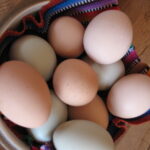
The chickens kept on laying eggs.
Fall’s Shortening days signals chickens to slow egg production just as many families need plenty of eggs for the holiday baking season. Placing a timer-controlled light in the coop, set to come on early each morning, gives chickens the optimal 15 hours of combined artificial and natural light they need to keep laying.
Lights and timers need electricity that our barn lacked. So, years ago, we hired an electrician to trench a wire from our house to the barn and add outlets and overhead lights. It works fine but the electrician’s bill was stiff and our chicken lights add to our monthly power bill. Now there’s a less expensive option.
P.S. The Holidays are coming….This might be a great gift for chickens and caregivers!
-
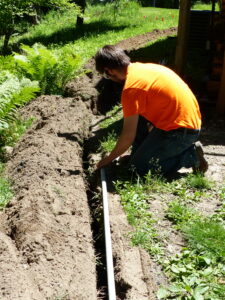
-
After trenching the wire was laid down.
-
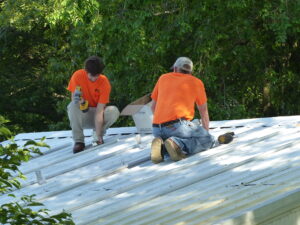
-
We hired a company to install solar panels on the barn roof.
-
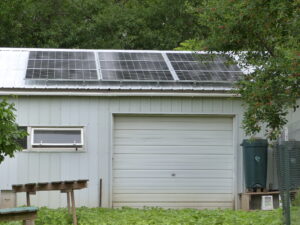
-
Solar powers our home and the light needed for the coop.
Batteries, light bulbs, and solar collectors have become much more efficient and less expensive. It’s now easy to purchase a solar electric system to power outbuildings that lack electricity.
Alternative Light Options
Big box stores sell security lights that include a solar collector, occupancy sensor, battery, and light bulb. The collector creates electricity during the day that charges the battery. The sensor recognizes when a person approaches in the dark and turns on the light. These are fine for their intended purpose but don’t work to add a few extra hours of timer-controlled light for chickens.

A portable solar kit costs around $400, is easy to install and to light your way. (Courtesy Solar Illuminations)
We recently learned of a company called Solar Illuminations, which can create lighting solutions for chicken coops and other outbuildings. A kit including a solar collector, battery, timer, fixture, and the bulb is just over $400. Sounds expensive but likely is less costly than hiring an electrician to run a wire. And, the sun never sends a bill for electricity generated by a solar panel.
Installing a system is easy and doesn’t require an electrician. Systems can also be designed to power an aquarium aerator that will help keep drinking water unfrozen on cold nights or provide work light in an outbuilding.
We love modern technology’s ability to harness the sun’s energy to give hens a few extra hours of light during winter’s darkness. The result is more eggs without adding a penny to the monthly electric bill.
*Note: Winding Pathways received no special compensation or materials from companies in writing this blog.
by Winding Pathways | Oct 14, 2021 | (Sub)Urban Homesteading, Chickens, Garden/Yard, Garden/Yard, Hoover's Hatchery, Nature
As we entered our driveway a frustrating sight greeted us. We were looking forward to picking the enormous seed heads of sunflower plants towering over the garden. Not this year. While we were gone, a windstorm toppled them a few weeks before they’d ripen.
That’s the way it is with gardening. Sometimes there’s a great success resulting in delicious meals. Then there are flops, like our sunflowers. We found more wind mischief. Several almost ripe pumpkins and squash had broken stems, dooming them to rot instead of ripening.
A Silver LIning
All wasn’t lost. We pitched the sunflower heads, pumpkins, and squash into our chicken run. Enthusiasm erupted as the hens eagerly devoured them. They pecked a hole in the squash and pumpkins, ate all their seeds, and then made quick work of eating the soft interior flesh. Soon all that remained was the tough outer skin of the pumpkin and the sunflower’s now seedless head. These went into the composter.
Chickens love garden debris and vegetables that don’t quite make it to our table. When fall closes down our garden we turn in the chickens. They chow down on bugs, weed seeds, and unripe vegetables. This makes clean-up easier and probably reduces next year’s insect and weed problems. A few days after Halloween our hens love snacking on our shriveling Jack O Lantern. They also relish seeds scooped out of winter squash and most vegetables left in the refrigerator a bit too long.
It was frustrating losing our sunflowers, pumpkins, and squash. Thanks to our industrious hens we were able to put them to good use.
-
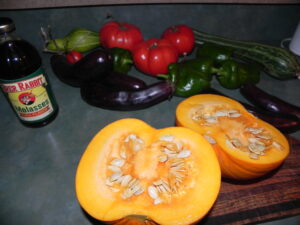
-
Seeds ready to eat.
-
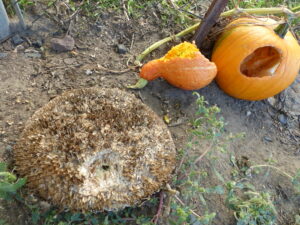
-
Holes pecked in pumpkin.
by Winding Pathways | Oct 7, 2021 | (Sub)Urban Homesteading, Chickens, Garden/Yard, Nature, Pests
There’s a Mouse in the House!
Sooner or later anyone who keeps a few chickens is likely to spot a mouse scurrying across the coop floor. Most sightings are after dark when hens are snoozing on their roosts. That’s when nocturnal mice seek a chicken feed dinner.
Commercial chicken feed is nutritious to more than chickens. Small rodents also thrive on it. They eat expensive feed and also foul it with their urine and droppings. Mice should be eliminated from the coop.
Two general types of mice can be found in places where both people and chickens live. European house mice are common all over the world. They usually spend their entire lives in a home or chicken house and rarely venture outdoors. These tiny rodents are dark gray all over. White-footed, or deer, mice are native rodents that commonly visit coops and the homes of the flock owner. They are easy to distinguish from house mice since, as their name implies, they have white feet and bellies.
While house mice live in a coop year round white-footed mice are more likely in cooler months. House mice usually eat food in place, while white footeds often carry seeds a distance and cache them in a hidden place to nibble on later. Find a pile of corn in an old boot or any other hidden place and the culprit is likely a white-footed mouse.
It’s not good to have either type of mouse mixing with chickens. Although it’s probably not possible to totally eliminate them, several actions greatly reduce their abundance.
The best strategy for reducing mouse infestations in either a house or chicken coop is to keep them out. Mice are tiny and athletic. They can squeeze through small holes and cracks, the same openings that let cold drafts enter. Keep both mice and cold air outside by filling in holes and cracks with caulking. The best time to do this is in early fall before cold weather settles in. Filling cracks also keeps box elder bugs, Asian beetles, and other insect pests outdoors. Cracks can be anywhere but are especially likely around window and door frames and where wires and pipes enter a structure.
Contain Food
Mice enter a chicken coop to find shelter from bad weather, safety from predators, and dinner. They love eating grain and chicken mash or pellets. Anything edible in the coop should be stored in metal containers with tight-fitting lids. Mice easily chew through plastic ones so avoid them. Use metal trash cans instead. Mice will help themselves to feed in a feeder, and most people leave feeders exposed at night. Since chickens don’t eat during dark hours put feeders in a tightly lidded metal garbage can overnight. This will keep mice away from them. The feeders can simply be put back where the chickens can access them the following morning.
Encourage Owls
A neighborhood owl family can be a chicken’s best friend. Owls love dining on mice. Great horned, barred, and screech owls are relatively common in suburban areas and patrol nighttime neighborhoods seeking small mammals to catch and eat. Owls are active when chickens are securely sleeping in the coop. This reduces the odds that a hen will end up an owl meal. According to Karla Bloem, Executive Director of the International Owl Center, owls can be a chicken keeper’s best friend.
Avoid Poison and Glue Boards
Although it’s tempting to use poison to rid a home or chicken coop of mice it should be avoided for these reasons:
- Poisoned mice might be eaten by chickens, non-targeted wildlife, and pets. They can be sickened or killed by residual poison in the mouse’s body.
- Poisoned mice sometimes die between walls or in inaccessible places. Soon their bodies smell terrible.
- Poison is slow acting and cruel. A quick death by a snapping trap is more humane.
- Chickens, children, pets, and nontarget wildlife might find and eat the poison.
Glue boards are pieces of cardboard or heavy paper covered with an extremely sticky substance. A mouse walking over a glue board will be held tightly. They can’t escape. While glue boards catch mice they also catch non-targeted animals. Any human who touches the sticky stuff will struggle to get free of it. Mice caught in glue boards usually starve to death or are found alive and struggling. It’s cruel.
Mice are relatively easy to trap using any of the many devices on the market. Most common are snap-type traps that have been effectively catching small rodents for over a century. For people who prefer not to touch a dead mouse, newer type traps enclose the entire body. Some traps are even electronic and electrocute the poor animal. There’s even a trap that will alert a cell phone when a mouse has been caught.
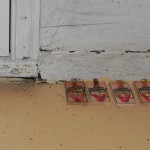
Place several traps side-by-side along a wall where you have seen evidence of mice.
Despite the fancy new type traps the old-fashioned kind, baited with peanut butter or soft cheese, is most common and least expensive. Traps should be set in places where chickens, pets, and children can’t access them. It’s best to set traps in the evening and either spring or retrieve them the next morning. Following are tips for increasing trapping success:
- Mice tend to run parallel to walls. Set traps next to walls with the trigger end closest to the wall. Traps with yellow plastic triggers that look like cheese may be slightly more effective than the older traps with metal triggers.
- Set traps in pairs or triplets. Put two or more traps side by side along the wall for the best odds of catching a fast-running mouse.
- Set out many traps. The best way to reduce mouse numbers is to catch all, or most, of the mice in the same evening.
- Don’t assume they’ve all been caught. Usually, there are many mice in a coop or home. Once most have been caught, keep setting them. Likely a few mice remain or new ones may enter.
Dispose of dead mice by flushing them down the toilet, putting them in the trash, burying them, or placing them in a woodsy or tall grassy area for scavengers to eat. Chickens will eat mice, also. Wash your hands well after touching the traps or mice.
Reducing mouse numbers in a coop is an important part of chicken husbandry. It takes some effort but preventing an infestation and trapping any that lurk in the coop is important.
*Reprinted with permission from Hoover’s Hatchery.
by Winding Pathways | Sep 30, 2021 | Garden/Yard, Nature, Pests
Poison ivy is a universally disliked and feared plant. It seems to grow everywhere. Encounter it and risk an itchy rash…..or worse. Some people are so sensitive to the oil on the leaf’s surface that they end up hospitalized.
Despite the discomfort it causes, poison ivy is an amazing native plant. It’s tough and thrives in any soil type, in drought or deluges. It loves living in the woods, at the edge of lawns and ballfields, and even in city vacant lots. It grows along ocean beaches and up mountains.
Scratching people may disagree, but there are two things to love about poison ivy. Both happen in the fall.
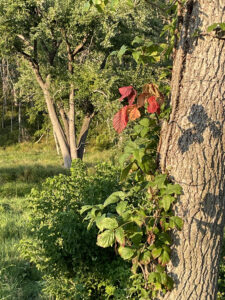
Keep your distance from this beguiling, colorful plant.
As days become cooler and daylight shortens poison ivy is one of the first plants to turn color. A month before sugar maples color up poison ivy leaves turn a glorious deep red. By late fall birds enjoy eating plentiful poison ivy berries. Apparently, they don’t get the itch and happily spread the common plant’s seeds when they poop them out.
There is one certain way to prevent a poison ivy itch. Enjoy it from a distance. Only contact with the plant’s oil can cause a rash. This can happen by touching the plant leaves or vines, patting an animal that has run through a poison ivy patch, accidentally touching clothes that have rubbed by poison ivy, or by breathing smoke with the oils in it when an area is being burned has poison ivy in it.
by Winding Pathways | Sep 23, 2021 | (Sub)Urban Homesteading, Garden/Yard, Nature, Trees
Coppicing
What? Coppicing? That word almost sounds dirty. Well, it’s not. It is a good way to help derecho doomed trees live on!
We recently hosted friends to mark the first anniversary of the August 10, 2020, furious derecho that leveled around 70% of trees in the Cedar Rapids area.
Many people used words like devastation and destruction to describe what happened to trees in both forests and neighborhoods. The damage was truly shocking.
-
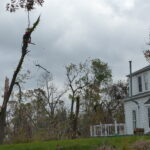
-
Trimming damaged trees.
-
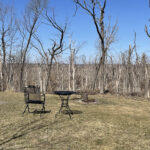
-
All winter we looked on broken trees.
-
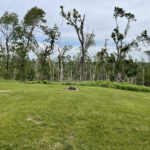
-
Springing Back from Derecho.
The Giving Trees
We wanted to show visitors a miracle of nature stimulated by the storm. Just east of our house stood a couple of basswood trees. Few of nature’s scents are as delightful as what comes from the blooms of this tree. Bees will fly three miles away to gather the nectar. We just enjoy the scent.
Basswoods have a problem. Their wood is soft and weak. When the derecho hit, they quickly snapped off, leaving a tangle of branches in our yard. Nearly a year later they demonstrated the power of near-perpetual youth.
-
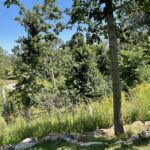
-
In the middle our basswood looks like a fuzzy brush.
-
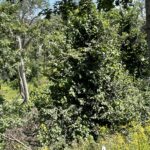
-
This basswood wants to live!
Basswoods, along with many other deciduous trees, readily coppice. If a tree is cut or blown down it sends shoots up from the stump. Our basswoods quickly sprouted this spring, and we’re seeing others sprouting from stumps in suburban yards. Many species of deciduous trees also send up shoots. Ashes, oaks, and honey locusts are common sprouters. Evergreens don’t. If a pine or spruce is cut off, the stump dies.
Woodland Management
In Europe coppicing is a method of woodland management. A tree is cut down and allowed to resprout. Because the regrowth is coming from a well-established root system, sprouts grow like crazy. The sprouts are managed carefully. The most hearty sprout is kept and the others cut off. Within five to twenty years, or so, the hearty sprout is big enough to cut for firewood, fence posts, or walking sticks. Then the stump resprouts again. Some trees have been coppiced for hundreds of years.
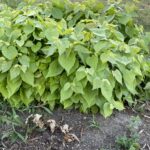
Basswood trees are champion sprouters. Our stumps now look like balls of green leaves from all the sprouts radiating from the stumps. This fall we’ll clip off all but the most vigorous one. It will quickly form a new tree. That’s better, easier and cheaper than grubbing out the stump, then buying and planting a replacement tree.
-
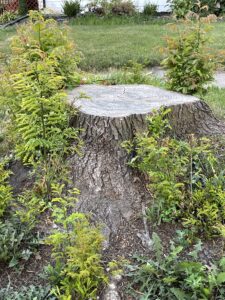
-
The Giving Tree
-
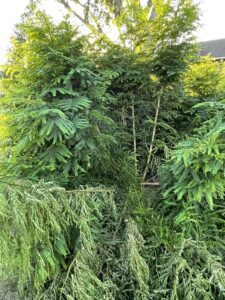
-
A look at the stems of new sprouts
-
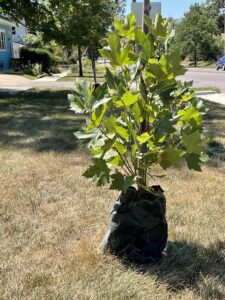
-
the original new tree died, but sprouted from the bottom.
-
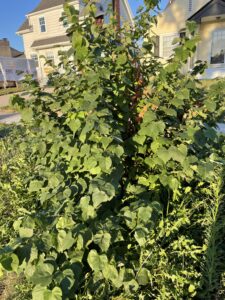
-
Repairs continue as damaged trees sprout.
An Internet search will turn up much information on coppicing. We like the website of the Midwest Permaculture Center.
by Winding Pathways | Sep 9, 2021 | Garden/Yard, Nature, Pests, Trees/Shrubs
We’ve got a peach problem.
Iowa’s frigid winters don’t favor peach trees, but we’ve got a tough one in the front yard that’s withstood temps down to 30 below zero. Each May it graces our yard with pink blossoms that transform into smallish, tasty peaches that ripen around Labor Day.
We love peaches. So do deer. That means that every fall we play a waiting game with them.
Peaches look ripe a few weeks before they truly soften and ripen. When they’re hard as stones they don’t taste good. We know it. So do the deer. This starts the tricky part.
When will they be ready to pick? If we don’t harvest them at just the right time the deer will do it for us. They’ll devour every single one the night before we intend to pick. This year we ran a wide circle of wire mesh around our tree, but we know hungry deer will figure out how to foil it.
-
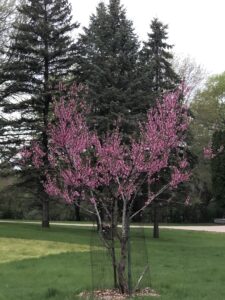
-
Each spring the fragrant pink blossoms grace our yard.
-
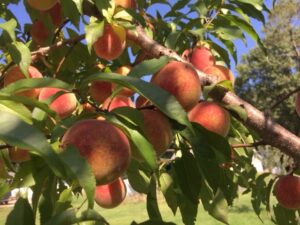
-
Deer sense when peaches are ready to eat.
As we write this on September 2nd our peaches are still hard. The deer are watching and waiting. We know because we found fresh scat just outside the wire fencing last night. We’ll let our readers know who gets the harvest.
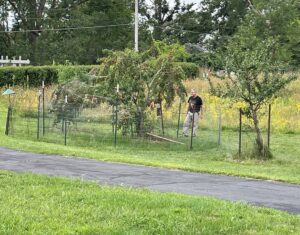
Adding extra fencing and stakes may keep the deer back.






















